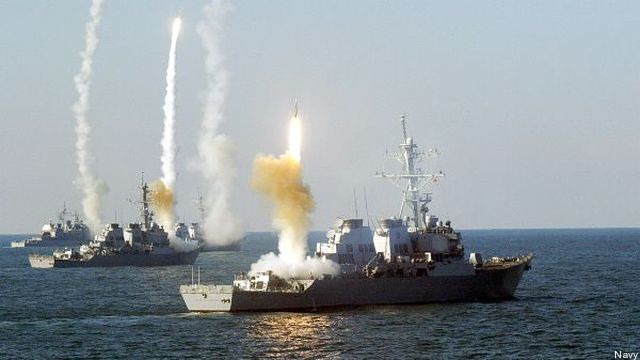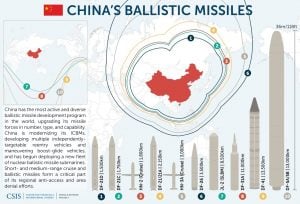The Navy Has Had Enough of Missile Defense And Sees Its Chance
Posted on

Navy Aegis ships
WASHINGTON: The Navy is looking to get out of the missile defense business, the service’s top admiral said today, and the Pentagon’s new missile defense review might give the service the off-ramp it has been looking for to stop sailing in circles waiting for ground-based missile launches.
This wasn’t the first time Adm. John Richardson bristled in public over his ships sailing in “small boxes” at sea tasked with protecting land, when they could be out performing other missions challenging Chinese and Russian adventurism in the South China Sea and the North Atlantic.
His comments come days after the Pentagon finally released its long-awaited Missile Defense Review which doubled down on plans to develop a space-based sensor layer that can track — and potentially zap — missiles fired not only by Iran and North Korea, but competitors like China and Russia, as well.
“We’ve got exquisite capability, but we’ve had ships protecting some pretty static assets on land for a decade,” Richardson said at the Brookings Institute. “If that [stationary] asset is going to be a long-term protected asset, then let’s build something on land and protect that and liberate these ships from this mission.”
Japan is already moving down the path of building up a more robust ground-based sensor and shooter layer, while also getting its own ships out to sea armed with the Aegis radar and missile defense system, both of which would free up American hulls from what Richardson on Monday called “the small boxes where they have to stay for ballistic missile defense.”
By 2021, Tokyo plans to have eight Aegis destroyers at sea, four of which will be capable of launching SM-3 Block IIA missiles — including two new Aegis-equipped Maya-class destroyers, the first of which is set for delivery in 2020. In September, in fact, a Japanese Atago-class destroyer knocked down a mock ballistic missile off the coast of Hawaii in the second successful test of its burgeoning capability.

Japanese Atago-class ships with the Aegis system.
In July, the Abe government in Tokyo announced that it was planning to buy two ground-based Aegis Ashore systems from Lockheed Martin for $1.2 billion, a move that underscores Japanese unease at the Chinese military buildup and the continuing North Korean threat.
Those purchases and successful tests are not only music to Richardson’s ears, but also fall squarely within the policy spelled out by the Trump administration, which is calling for allies to invest more in their own defense — and buy American while they’re doing it.
Back in June, Richardson lamented the number of ships he had in the water near Japan and South Korea scanning the skies for North Korean missile launches,. “Right now, as we speak, I have six multi-mission, very sophisticated, dynamic cruisers and destroyers ― six of them (that) are on ballistic missile defense duty at sea,” he said. “So we have six ships that could go anywhere in the world at flank speed, in a tiny little box, defending land.”
Bluntly, he added, “I want to get out of the long-term missile defense business and move to dynamic missile defense.”
While the missile defense review might give Richardson and those in the Navy looking to move past some elements of the missile defense mission, those changes won’t come any time soon.
The review makes no final determinations over what space-based interceptors or directed energy weapons might be developed or fielded in the future, instead calling for over a dozen separate studies to refine concepts for all potential ground and space-based options. Most of those studies are already under way, but it will take years for any of them to evolve into actual capabilities, meaning Aegis destroyers will continue sailing in those “boxes” for the foreseeable future.
Richardson also played down the risk vulnerabilities of US aircraft carriers, which some say are just big targets waiting for a Chinese DF-21 (or one of the other variants of “carrier killer” missiles) to sink them. In particular, analysts have grown increasingly concerned over Chinese and Russian advances in hypersonic weapons that travel too fast to be countered by today’s US defenses.

Types and ranges of Chinese ballistic missiles (Center for Security & International Studies)
On Monday, Chinese television broadcast new video of the DF-26 (an upgrade of the DF-21) intermediate-range ballistic missile that has a range estimated at 1,800 to 3,500 miles. The footage showed off several technical advances designed to increase the missile’s accuracy. China confirmed in April that the weapons had been deployed to active-duty units, but the new footage was dropped a week after two US warships sailed through the Taiwan Strait, and Richardson, during a visit to Japan, refused to rule out sending an aircraft carrier through the waterway still claimed by China.
This morning Adm. Richardson again refused to rule out an American big deck weaving its way between Taiwan and mainland China, and he defended the future of the carrier.
“There’s a great virtue in being able to move an airfield 720 miles in a day,” he said. “So rather than talking about the vulnerability of the carrier strike group, we should think about it as perhaps the most survivable airfield in the region.” With a new generation of Ford-class carriers coming into the fleet in the near future, that survivability is something the Navy is staking tens of billions of dollars — and thousands of lives — on.
Subscribe to our newsletter
Promotions, new products and sales. Directly to your inbox.
